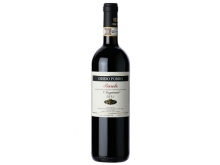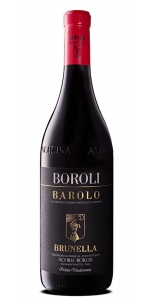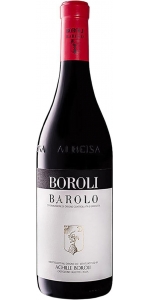Guido Porro Barolo Lazzairasco 2011
| Country: | Italy |
| Region: | Piemonte |
| Winery: | Guido Porro |
| Grape Type: | Nebbiolo |
| Vintage: | 2011 |
| Bottle Size: | 750 ml |
All older vintage wines have been purchased from a single collectors cellar. Pictures can be requested before shipment.
All older vintage wines have been purchased from a single collectors cellar. Pictures can be requested before shipment.
Boroli Barolo Brunella is made from 100 percent Nebbiolo.
A clear ruby red color, with very light orange reflections. A net aroma in which liquorice stands out at first, immediately followed by a fruity scent; the aroma makes you scent it again and again to discover different and pleasant facets. The fruity aroma magnificently prevails after a few minutes in the glass. A very enveloping, fresh and harmonious taste, with a delicate and tasty presence of wood. A long lasting taste that invites to sip it slowly again and again.
Tasting Notes
Brunella is distinguished by a careful selection of grapes, perfect destemming, long macerations with submerged cap. The barrels for Brunella are specifically chosen by the winemaker.
Wine Production
Brunella is one of the most historic single vineyard sites of all of Castiglione Falletto, however it hasn’t ever been bottled singularly under the Menzione Geografica Aggiuntiva BRUNELLA until 2013. The Brunella vineyard occupies the western crest of the Villero hillside and complete surrounds the Boroli winery. The vineyard is a monopole—owned entirely by Boroli and is the most prestigious wine in the lineup. As it occupies the best exposed section of the Villero hillside, La Brunella expresses power, drive, complexity, and extraordinary length and ageability.
About the Vineyard
The Boroli family is a family of entrepreneurs, with roots in Piedmont dating back to 1831. The family started their winemaking business in1997, when Silvano and Elena Boroli felt an ardent desire to step away from the pressures of their publishing business and reconnect to nature. Silvano and Elena grew the company until their son, Achille, stepped in to run the wine-growing and production business in 2012.
With the 2012 grape harvest Achille decided to radically change the methods used in vineyards and wineries, aiming for the highest quality in Barolo and its crus. He cut production levels, updated the winemaking technology, and focused on low intervention methods to raise the quality of the Boroli wines be on par with the finest Barolo wines.
Review:
Ripe red cherries and blood oranges, as well as herbs and roses on the nose, leading to a juicy and flavorful palate that has a swathe of bright, juicy red-fruit flavor. Drinking well now.
-James Suckling 93 Points
Boroli Barolo Brunella is made from 100 percent Nebbiolo.
A clear ruby red color, with very light orange reflections. A net aroma in which liquorice stands out at first, immediately followed by a fruity scent; the aroma makes you scent it again and again to discover different and pleasant facets. The fruity aroma magnificently prevails after a few minutes in the glass. A very enveloping, fresh and harmonious taste, with a delicate and tasty presence of wood. A long lasting taste that invites to sip it slowly again and again.
Tasting Notes
Brunella is distinguished by a careful selection of grapes, perfect destemming, long macerations with submerged cap. The barrels for Brunella are specifically chosen by the winemaker.
Wine Production
Brunella is one of the most historic single vineyard sites of all of Castiglione Falletto, however it hasn’t ever been bottled singularly under the Menzione Geografica Aggiuntiva BRUNELLA until 2013. The Brunella vineyard occupies the western crest of the Villero hillside and complete surrounds the Boroli winery. The vineyard is a monopole—owned entirely by Boroli and is the most prestigious wine in the lineup. As it occupies the best exposed section of the Villero hillside, La Brunella expresses power, drive, complexity, and extraordinary length and ageability.
About the Vineyard
The Boroli family is a family of entrepreneurs, with roots in Piedmont dating back to 1831. The family started their winemaking business in1997, when Silvano and Elena Boroli felt an ardent desire to step away from the pressures of their publishing business and reconnect to nature. Silvano and Elena grew the company until their son, Achille, stepped in to run the wine-growing and production business in 2012.
In the 2012 grape harvest Achille decided to radically change the methods used in vineyards and wineries, aiming for the highest quality in Barolo and its crus. He cut production levels, updated the winemaking technology, and focused on low intervention methods to raise the quality of the Boroli wines be on par with the finest Barolo wines.
Review:
Solid and centered, it displays a splendid Mediterranean character reminiscent of rosemary, wild thyme, marjoram, lemons, and red plums. Full body, perfectly extracted tannins of commendable beauty, and a slender yet disturbingly charming finish. Wow! Better from 2024
-WineCritic.com 96 Points
Boroli Cerequio is made from 100 percent Nebbiolo.
The Boroli family is a family of entrepreneurs, with roots in Piedmont dating back to 1831. The family started their winemaking business in1997, when Silvano and Elena Boroli felt an ardent desire to step away from the pressures of their publishing business and reconnect to nature. Silvano and Elena grew the company until their son, Achille, stepped in to run the wine-growing and production business in 2012.
With the 2012 grape harvest Achille decided to radically change the methods used in vineyards and wineries, aiming for the highest quality in Barolo and its crus. He cut production levels, updated the winemaking technology, and focused on low intervention methods to raise the quality of the Boroli wines be on par with the finest Barolo wines.
About the Vineyard
The Cerequio cru lies just across the valley from the Boroli winery in the commune of La Morra and is considered one of the most prestigious sites in the Barolo DOCG zone. It is known to produce Nebbiolo wine of enormous elegance and finesse.
Wine Production
Cerequio is distinguished by a careful selection of grapes, precise destemming, and a long maceration with submerged cap.
Tasting Notes
A clear bright ruby color with very light garnet red reflections; intense and persistent aroma of red fruit with notes of plum and cherry. A pleasant aroma of wood is noticeable after the fruity aroma, anticipating the full taste of a great wine suitable for long lasting life. A succulent, rich, full-bodied and pleasant taste emerges after the woody one, with the presence of slightly ripe red fruit.
Food Pairing
Thanks to its viscosity and body, Barolo is the ideal wine to pair with elaborate dishes and dishes like truffle dishes, meat dishes, pasta with porcini mushrooms, game, and aged cheeses. Cerequio is also perfect with dry pastries or chocolate.
Review:
Precise and essential, it displays notes of lavender, hibiscus, violet, white pepper, lime, jasmine flowers, and elderberry. Medium body, perfectly ripe, fine-grained tannins, and a juicy finish that displays smoothness and relaxation. Beautiful right away, it will only improve from 2024 onwards. One of the best Barolos tasted in the 2019 vintage.
-WineCritics.com 96 Points
Boroli's Barolo is made by a special combination of careful grape selection, precise destemming, and long mascerations with submerged cap. The barrels used to age this wine are very carefully chosen by the winemaker.
Clear bright ruby color with very light garnet red reflections; intense and persistent aroma of red fruit with notes of plum and cherry. A pleasant aroma of wood is noticeable after the fruity aroma, anticipating the full taste of a great wine suitable for long lasting life. A succulent, rich, full-bodied and pleasant taste emerges after the woody one, with the presence of slightly ripe red fruit.
Barolo pairs perfectly with rich dishes such as roasted meats and pasta with truffles.
Review:
A relatively easy-drinking Barolo. Layered fruit on the nose with strawberries and red cherries, together with violets and some licorice. On the medium-bodied palate there’s a light frame of dusty tannins and a sense of freshness. Simple yet precise.
-James Suckling 91 Points
#31 in Wine Enthusiast Top 100
Fresh scents of just-picked rose, bright red berry, baking spice, leather and an earthy hint of game unfold on this stunning wine. The full-bodied palate offers juicy mature cherry, crushed raspberry, licorice, carob, chopped wild mint and clove alongside firm, velvety tannins and bright acidity. -Wine Enthusisat 95 Points
Guido Porro:
Reviews and notes on Guido Porro regularly refer to him as “under the radar”: the wines he makes are worthy of a stellar reputation, but he is too easygoing and unassuming to worry about whether the general wine-drinking public recognizes his name. He rarely bothers to send samples to wine writers. Guido is the fourth generation at an estate that has always been passed from father to son, and although fifth-generation Fabio hasn’t reached middle school, he is already showing a keen curiosity in the family business. The Porros continue to work just as their predecessors did—the only major change over the last few decades has been the decision to bottle at the estate instead of selling the wine in demijohns or barrels—and they like to keep things simple and down to earth. The door is always open, and Guido’s wife Giovanna never looks quite as happy as when she’s serving enormous platters of classic local dishes to a full table of guests.
The limestone-heavy soils of Serralunga d’Alba are known for providing the most long-lived and full-bodied Barolos. Porro’s vineyards are located here in the Lazzarito cru, a gorgeous amphitheatre that faces south-southwest and offers the grapes full sun exposure and protection from the wind. The sub-zones of Lazzairascoand Santa Caterina are both monopoli and share the same soil; however, different exposition and altitude bring distinct traits to each wine. Lazzairasco, a very hot site home to Guido’s oldest Nebbiolo, gives a more powerful, masculine wine, while the cooler, breezier Santa Caterina brings out the delicacy and elegance of Nebbiolo. Even Porro’s Barbera, a grape that is usually planted in lesser vineyards, enjoys a privileged place inSanta Caterina. Guido sticks to traditional methods in the vineyards and cellar, and he never gets in the way of the grapes’ natural expression.
VITICULTURE / VINIFICATION
• Vines are sustainably farmed, the equivalent of lutte raisonnée in France.
• Only indigenous yeasts are used
• Almost all barrels used (barriques, tonneaux, and botti) are at least 5th passage; new barrels are introduced occasionally as needed
• The Lazzairasco, Santa Caterina, and l’Pari vineyards are all monopolies
Langhe Nebbiolo “Camilu”:
• Maceration in cement vats lasts 20-25 days; pumping over 3-4 times daily
• Six or seven months in 500-L tonneaux
• Vines are located in the Serralunga within the Barolo DOCG
Langhe Rosso “Paesan”:
• Nebbiolo and Barbera vinified and matured separately
• Maceration in cement vats lasts 20-25 days; pumping over 3-4 times daily
• Nebbiolo: 1 year in tonneaux
• Barbera: 1 year in barriques
Dolcetto, Barbera:
• Maceration in cement vats lasts 7-12 days; pumping over 3-4 times daily
• Dolcetto: 2 months in botti then 10-12 months in cement vats before bottling
• Barbera: 4-6 months in botti then about 6 months in stainless steel before bottling
Barolos:
• Maceration in cement vats lasts 20-25 days; pumping over 3-4 times daily
• Three years in 15- to 25-hl Slavonian oak botti
Lazzairasco and Santa Caterina:
• Both vineyards in the Lazzarito cru of Barolo
• Lazzairasco: 300-350 m altitude; S/SE exposure
• Santa Caterina: 340-390 m altitude; SW exposure
- back
All older vintage wines have been purchased from a single collectors cellar. Pictures can be requested before shipment.
SALE
Palacio de Bornos Verdejo Rueda is made from 100% Verdejo.
Mechanical and manual harvest. Fermentation takes place in stainless steel tanks at controlled temperature of 15-16º C for 18 to 20 days. Cold stabilization, filtration. Clay and limestone with small round stones.
Straw-like yellow color with fresh green tones.
Hugely aromatic, with tropical fruit, tangerine, lemongrass and lemon thyme. Fruity notes with anise and minerals, typical of the Verdejo grape. Full in the mouth, well structured, dense and persistent with a lingering aftertaste. The wine has great length and a delicious mouth-filling richness, and finished with a precise acid cut.
As a light aperitif, ideal at any time of the day, with a tapas or small snack, with Pasta al Pesto, Mousse of Tuna fish and lime..
Enjoy with everything from sushi to spicy Cajun shrimp!









